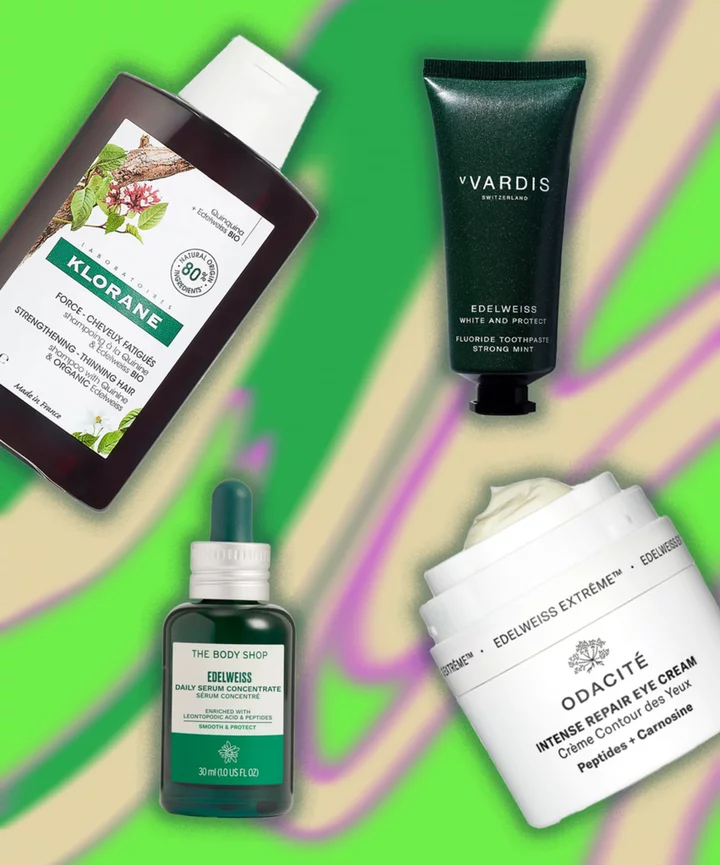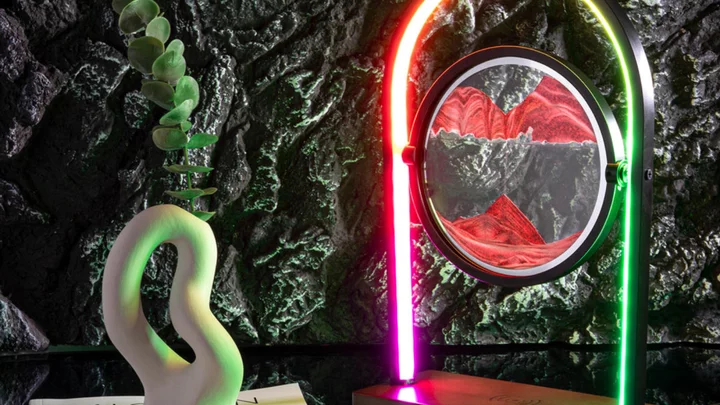Autumnal foliage, spiced lattes, and cuffing season are cute and all, but consider it quite literally the calm before the storm: Thanks to a rise in extreme weather events, it’s only a matter of weeks before polar vortexes, bomb cyclones, atmospheric rivers and, yes, thundersnow (a snowstorm spiked thunder and lightning), come for our comfort and complexions, drying and irritating skin along the way. For the mountain flower edelweiss, gale-force winds, freezing temperatures, and sheets of snow are just another day at the office. The star-shaped flower, which is native to the rugged Swiss and Austrian alps, is known to stand up to the most intense weather patterns — and still emerge looking soft and delicate, largely thanks to its antioxidant-packed composition. The plant’s uncanny ability to thrive in heightened weather conditions is a feat of resilience so impressive, the beauty industry is using edelweiss as a super ingredient for just about every product category on the market.
Often listed on labels by its taxonomic name, leontopodium alpinum, edelweiss is included in hair-strengthening and scalp-soothing treatments; as an antibacterial agent in oral care; and for its antioxidant and anti-inflammatory properties in skincare and even makeup. The ingredient is emerging as such a skincare star that it’s touted in prestige formulas (like Swiss-made Bellefontaine) and more affordable ranges too. In a particularly brazen vote of confidence, The Body Shop recently rebranded it’s already bestselling Drops of Youth skincare range as the Edelweiss Skincare collection, using the extract and stem cells from the plant as the star ingredient in ten products (that include masks, moisturizers, and serums) — all after a proprietary clinical trial showed the ingredient to deliver retinol-like properties and (without the irritation).
What is edelweiss?
The stout, white flowering botanical, named “edelweiss” has held a prominent place in alpine culture, with soldiers going to great lengths to pick the flower in high-altitudes, then present it a way to profess undying love (The Bachelors and their roses could never). While it’s more commonly known as something to sing about in The Sound of Music (the plant representing Captain von Trapp’s noble patriotism to his native Austria and resistance to join the Nazi Navy), in the Alps, the plant’s medicinal properties have made it a mainstay in traditional remedies for thousands of years. The herb was traditionally used in folk medicine for its anti-inflammatory and antimicrobial benefits: it was boiled in wine and mixed with milk to treat oral conditions and otherwise used to address ailments ranging from menstrual cramping and respiratory issues to dysentery.
Edelweiss’s legacy perseveres as a go-to home remedy in the Alpine region: Celebrity makeup artist Monika Blunder, founder of makeup and skin-care brand Monika Blunder Beauty, grew up in Austria, where her father concocted a blend of alcohol-based edelweiss and arnica extract for use like hydrogen peroxide. “We used it for every little cut, burn, or bruise we got and it was so effective at healing and soothing the skin,” she says. “It really felt like magic.”
What are the benefits of edelweiss?
Today, edelweiss extract is sought after in skincare for its high levels of chlorogenic and leontopodic acids, both of which have been found to carry strong antioxidant activity (like vitamin C) and improve skin elasticity, dermal density, and skin thickness (therefore contributing to wrinkle reduction). Meanwhile, lignans (a type of polyphenols with antioxidant properties) found in the plant have been shown to calm skin. Biotech companies have also made anti-aging skincare ingredients from the plant’s stem cells to help prevent degradation of the dermal matrix (which includes treasured elastin and collagen) and the body’s own hyaluronic acid. What’s more, biotech and AI farming (enlisted by Odacité to optimize the potency of edelweiss actives) offers the plant’s power without depleting natural resources.
“In the case of edelweiss, the production of the active ingredients of the plant for cosmetic use is performed by harnessing the power of the plants stem cells and replicating them in vitro, which is helpful given the rarity of this plant,” says Rahi Sarbaziha M.D., a Beverly Hills-based anti-aging and integrative aesthetics specialist.
According to its supplier’s proprietary study (which, as with all non-clinical trials conducted or funded by brands, should be taken with a grain of salt), The Body Shop claims that its edelweiss extract and stem cell complex provided 43% more antioxidant properties than retinol acetate (a retinol derivative). The results prompted the brand to overhaul its top-selling skin-care range to include 50% more of its edelweiss complex. As a testament to its faith in the ingredient, The Body Shop also rebranded the line — which sells a product every 20 seconds — to include “edelweiss” in the name.
“About 80% of daily skin damage is caused by environmental aggressors like pollution, dust, UV radiation, and blue light, which can result in oxidative stress that leads to dry, dull, and tired skin,” said Laura Keane, global marketing director at The Body Shop. “Edelweiss extract is known to provide superior protection against free radicals by blocking fine dust, providing pollution protection, and helping to maintain the skin’s natural barrier function.” Keane calls edelweiss “the beauty industry’s best-kept secret.”
Alessandro Mendes, a chemical engineer and Vice President, Research & Innovation at cosmetic manufacturer Cosmetica Laboratories Inc., backs the idea of edelweiss as a beneficial beauty ingredient. “There are several scientific studies that support the efficacy of edelweiss to improve skin barrier, display strong antioxidant activity, increase moisturizing activity, and suppress inflammation,” he says. “The fact that there is research behind its benefits makes edelweiss very exciting from a technical perspective. Using an extract from a flower able to thrive and survive in such a harsh environment — heights over 1,500 meters, withstanding extreme temperatures of the alpine mountains — only contributes to the beauty of the product concept.” Mendes predicts we’ll see more of the ingredient in the near future. The indicators are strong: Over the past three years, there has been a 42% increase in global skincare and color cosmetic products launches containing edelweiss, according to Mintel Global New Products Database (GNPD).
As more brands blur the line between cosmetics and skincare, edelweiss is proving an attractive add-in to makeup as well. Blunder uses the extract across the entirety of her eponymous makeup and skin-care line in products ranging from foundation-concealer hybrid Blunder Cover and Liquid Flush Cheek Tint to Undercover Face Crème. “I’ve seen firsthand how effective plant extracts can be, and edelweiss is incredible,” she says. “As a celebrity makeup artist, creating products that help the skin stay calm and clear while you wear them just made sense.”
Should I replace my vitamin C with edelweiss?
While edelweiss’s antioxidant activity is compelling, both Rahi Sarbaziha M.D., a Beverly Hills-based anti-aging and integrative aesthetics specialist and S. Manjula Jegasothy, M.D, a Miami-based dermatologist, don’t exactly recommend replacing your trusty vitamin C. “The antioxidant effect of edelweiss is considered stronger than that of vitamin C, but vitamin C is more readily available and reproducible, which is why it’s so often seen in skin-care products,” says Dr. Sarbaziha. The ingredient has also been studied far more than edelweiss, says Dr. Jegasothy, which is part of what makes it a gold-standard antioxidant. Still, for those who find vitamin C products irritating, edelweiss may prove a promising option.
Edelweiss, Dr. Jegasothy, says, is generally tolerable for all skin types. While some botanicals can act as common allergens for those with sensitive skin, “edelweiss is somewhat unique in that it offers barrier protection, so it’s going to be less likely to cause irritation than other botanicals and, potentially, vitamin C,” she explains. Given the ingredient’s calming effects on the skin, and provided an edelweiss skin or makeup product is pH-balanced, the dermatologist calls edelweiss “a great botanical to try for those with eczema or sensitive skin.” Dr. Jegasothy notes that those with known skin allergies should talk to their dermatologists about trying new products.
What are the best beauty products with edelweiss?
From Swiss luxury brand Bellefontaine to The Body Shop, both of which use proprietary edelweiss flower extracts and stem cells across their product lines, it’s easy to try the ingredient at any price point.
Bellefontaine Elixir Beauty Essence To Replump, $980 (for a set of two)
This concentrated formula combines edelweiss with hyaluronic acid and peptides for a serum that absorbs instantly and didn’t irritate my skin following a microneedling-radio frequency treatment. Yes, it’s wildly pricey, but a scant three drops a day gave my combination skin a visible boost that justifies the splurge.
Odacité Edelweiss Extreme Intensive Repair Eye Cream, $68
An impressive degree of tech is crammed inside this teeny jar: In order to access edelweiss’s anti-inflammatory benefits without taking from nature’s natural reserves, the brand uses edelweiss grown in an indoor, AI-powered farm made to duplicate the plant’s native, rugged Alpine environment and yield leontopodic acid and chlorogenic acids at peak potency.
Barney’s New York Beauty Glocela Serum, $168
As Dr. Sarbaziha points out, optimizing edelweiss’s antioxidant power may best come via a serum formulation. “Try using a serum with high absorption potential, applied twice daily for at least two weeks to see the best results,” she says. This option doubles up on free radical fighters with the inclusion of antioxidant-rich edelweiss and vitamin C.
Stripes Evening Wear Moisturizing Night Cream, $80
Though this moisturizer is targeted to those with hormonal and menopausal skin, its retinol and squalane-infused formula is made to help increase bounce and skin barrier density for any skin type.
The Body Shop Edelweiss Liquid Peel, $27
For sensitive skin types, the incorporation of edelweiss in skincare can help open doors to product categories generally deemed too harsh, like peels. This gel gathers dead skin cells into little balls on the skin’s surface after it’s applied, left to sit, then massaged into skin a few minutes later — and leaves skin feeling incredibly smooth, but not not tingly or flushed like many peel products can.
Augustinus Bader The Serum, $390
Bader’s own proprietary tech (a complex known as TFC8) is said to usher raw ingredients (in this formula, squalane, vitamin C, and resveratrol, among others) to an environment where your own skin cells can begin a repair process. To this end, the fast-absorbing formula taps edelweiss extract to counter oxidative stress in the skin (brought on by UV rays and pollution). While it’s hard for me to suss out whether this occurred in my skin, I do love the bounce-y effect that daily use has on my complexion.
Monika Blunder Blunder Cover, $52
Given edelweiss’s antioxidant and skin-calming qualities, extending its skin-care benefits to a makeup routine is a no-brainer, particularly when it’s with this foundation-concealer hybrid that provides the most natural-looking coverage while nourishing the skin.
Oribe Serene Scalp Soothing Leave On-Treatment, $48
Though edelweiss products are currently surging in skin-care and cosmetics, hair-care brand Oribe tapped edelweiss plant oils and extracts way back in 2008 to be used in the brand’s signature complex, which is found in 85% of the hair-care products it makes. “We chose edelweiss specifically for its protective and antioxidant properties. It’s very resilient and known to survive in harsh conditions including high altitude and frost without losing its beauty,” says Michele Burgess, executive director of Oribe product development.
More recent research shows promise for the ingredient to inhibit the hair’s catagen phase, the transitional phase of hair growth in which growth slows and hair detaches from the follicle. “This is particularly interesting because it could actually help hair growth in the long or short term,” says Dr. Jegasothy.
Beyond its potential to protect from hair loss, Dr. Sarbaziha also deems edelweiss scalp-friendly,” as it can not only help with hair growth but with dandruff and hydration of the scalp too.
Oribe’s edelweiss-included Signature Complex and host of other soothing botanicals (like cucumber, chamomile, and aloe) are included in this treatment to calm and counter flaky scalp and dandruff. Bonus: Because the lightweight formula disappears on contact, it doesn’t leave our roots with a greasy-looking sheen.
Klorane Anti-Hair Loss Serum with Quinine and Edelweiss, $32
While all kinds of formulations use the botanical extract to protect hair from pollutants, Dr. Jegasothy suggests leave-in treatments to stoke hair growth. “The brief contact that shampoos and conditioners have with the hair won’t give enough time for the active ingredients to actually inhibit the catagen phase of your hair,” she says. “I’d suggest using a leave-in treatment product — and using it for an extensive period of time, because your catagen phase on given hair lasts about six weeks.” To this end, the leave-in serum may be the star of this three-step routine in delivering edelweiss’s hair growth benefits.
vVardis Soft Mint New White Enamel Anti-Aging Toothpaste, $29
Edelweiss’s use in oral care can be traced back thousands of years. In European markets, the tradition continues with several oral care brands that tout the ingredient as an antibacterial, anti-inflammatory, and even whitening agent in toothpastes and gels.
“Although there isn’t enough research that supports edelweiss as an antibacterial, it does have characteristics that can help improve your oral health,” says NY-based cosmetic dentist Dr. Daniel Rubinshtein, pointing to its antibacterial and anti-inflammatory properties to promote healthy gums and oral microbiome flora. “The generic antibacterial ingredients that are used in most of the toothpastes can be considered more toxic to the body, so finding alternate ingredients is a great idea, though I would want to see more research on the effects this plant has on oral health before I recommend it to my patients to use it solely to optimize their oral health.”
Incorporating edelweiss into a toothbrushing routine may offer additional antibacterial or tooth-brightening benefits, but until this is further proven in studies, Dr. Rubinshtein suggests asking your dentist or oral health provider to weigh in on the ingredients in a toothpaste (particularly if you have underlying conditions, allergies, or other concerns) to ensure you’re getting the best tooth protection in a tube.
vVardis (developed by a pair of Swiss-born dentists) includes edelweiss in toothpastes for its humectant and antibacterial properties. Sure enough, I found brushing with this lightly minty paste left a more hydrating mouthfeel. The formula also include a patented peptide to rebuild enamel, along with well-researched ingredients like xylitol (the consistent use of which has been shown to inhibit the growth of the cavity-causing bacteria) and calcium hydroxyapatite (which research shows as comparable to fluoride in tooth remineralization) to boost oral health.
At Refinery29, we’re here to help you navigate this overwhelming world of stuff. All of our market picks are independently selected and curated by the editorial team, but if you buy something we link to on our site, Refinery29 may earn commission.









